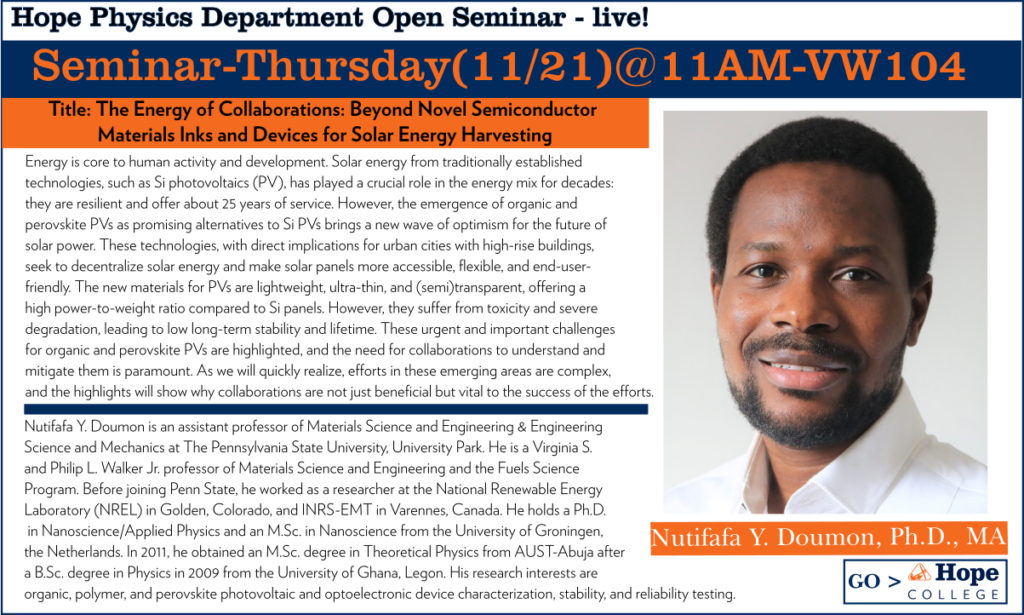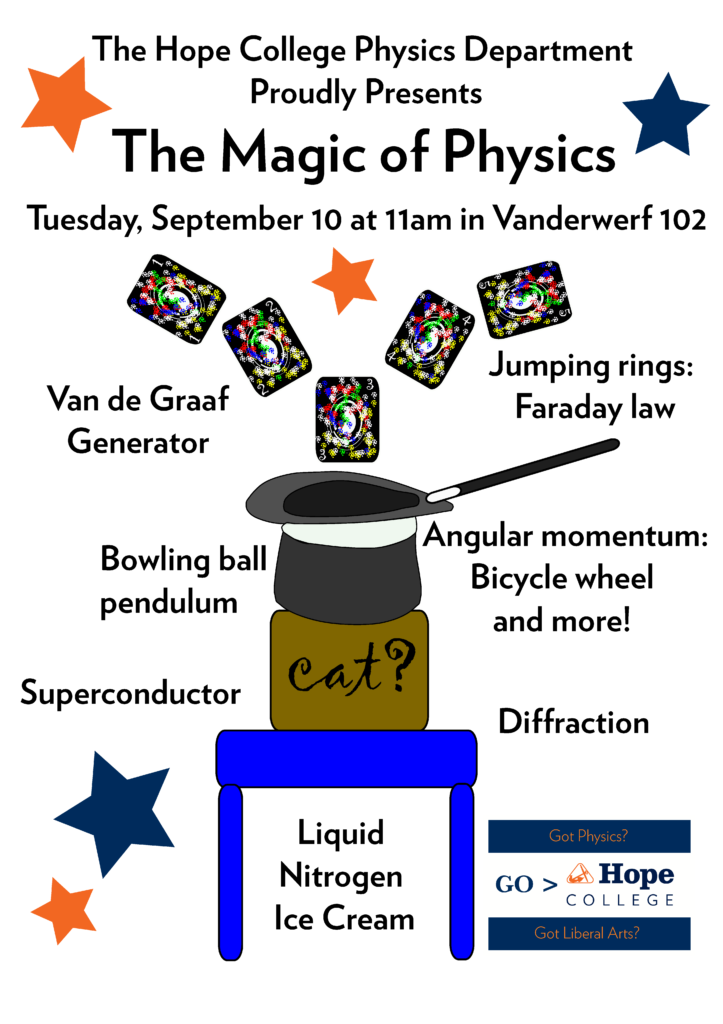Naomi Whitfield (Hope ’27) is a student who has double majors: Physics and Theater. She currently plays the film “Sense and Sensibility” at Dewitt main stage on April 4, 5, 10, 11, 12. Below are some of snapshots of her play.





Title: Beta-Delayed Neutron Spectroscopy of Fission Fragments with BEARtrap at Argonne National Laboratory
Abstract: Beta-delayed neutron emission properties are important to both basic science and applications-driven nuclear physics research. Branching ratios for these decays of neutron-rich nuclei play a role in r-process nucleosynthesis calculations as they are needed to determine final abundance patterns. The energy spectra of beta-delayed neutron precursors are also of interest to the development of advanced fuel cycles for nuclear reactors. As such, a dedicated ion trap and detector array, referred to as the BEtA Recoil-ion trap (BEARtrap), has been built at Argonne National Laboratory to study beta-delayed neutron emission via the recoil-ion technique. The experimental setup is located in CARIBU’s low-energy experimental area to study the large number of unmeasured beta-delayed neutron precursors generated by the forthcoming nuCARIBU upgrade. An overview of the experimental method, ion trapping and detector systems, as well as the upcoming first science case of the new apparatus will be presented.
Bio:
Postdoctoral Researcher, Argonne National Laboratory, Nov. 2021- present.
Ph.D. Physics, University of Notre Dame, 2021.
M.S. Physics, University of Notre Dame, 2018.
B.S. Physics, State University of New York at Brockport. 2015.
Title: Probing tiny jigsaw puzzles of nature
Abstract: The atomic nucleus consists of protons and neutrons, which are bound by the strong force. From only these two types of hadrons, thousands of unique isotopes are known to exist and exhibit both systematic and exceptional features. Their study is important not only for a better understanding of one of the fundamental forces of nature, but also for the origin of all elements observed in the universe.
Many large accelerator facilities have been built around the world in order to produce and examine these rare isotopes, some of which may have been created in exotic astrophysical environments. I will provide a general overview and recent developments in a select few topics of nuclear physics. While discussing personal research activities, I will also bring to light ongoing efforts in nuclear physics at Hope College.
Bio:

Title: The Energy of Collaborations: Beyond Novel Semiconductor Materials Inks and Devices for Solar Energy Harvesting
Energy is core to human activity and development. Solar energy from traditionally established technologies, such as Si photovoltaics (PV), has played a crucial role in the energy mix for decades: they are resilient and offer about 25 years of service. However, the emergence of organic and perovskite PVs as promising alternatives to Si PVs brings a new wave of optimism for the future of solar power. These technologies, with direct implications for urban cities with high-rise buildings, seek to decentralize solar energy and make solar panels more accessible, flexible, and end-user- friendly. The new materials for PVs are lightweight, ultra-thin, and (semi)transparent, offering a high power-to-weight ratio compared to Si panels. However, they suffer from toxicity and severe degradation, leading to low long-term stability and lifetime. These urgent and important challenges for organic and perovskite PVs are highlighted, and the need for collaborations to understand and mitigate them is paramount. As we will quickly realize, efforts in these emerging areas are complex, and the highlights will show why collaborations are not just beneficial but vital to the success of the efforts.
Nutifafa Y. Doumon is an assistant professor of Materials Science and Engineering & Engineering Science and Mechanics at The Pennsylvania State University, University Park. He is a Virginia S. and Philip L. Walker Jr. professor of Materials Science and Engineering and the Fuels Science Program. Before joining Penn State, he worked as a researcher at the National Renewable Energy Laboratory (NREL) in Golden, Colorado, and INRS-EMT in Varennes, Canada. He holds a Ph.D. in Nanoscience/Applied Physics and an M.Sc. in Nanoscience from the University of Groningen, the Netherlands. In 2011, he obtained an M.Sc. degree in Theoretical Physics from AUST-Abuja after a B.Sc. degree in Physics in 2009 from the University of Ghana, Legon. His research interests are organic, polymer, and perovskite photovoltaic and optoelectronic device characterization, stability, and reliability testing.

The Hope College Physics Department will present a public lecture for the Hope community that demonstrates six magical physics phenomena.
Time and Date: 11 am – 11:50 am, Tuesday, September 10
Location: Vanderwerf 102
Liquid Nitrogen ice-cream will be provided at the end of the lecture.
Please come and enjoy these mesmerizing physics demonstrations.